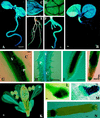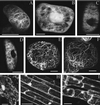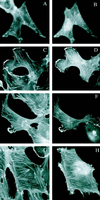Villin-like actin-binding proteins are expressed ubiquitously in Arabidopsis
- PMID: 10631247
- PMCID: PMC58842
- DOI: 10.1104/pp.122.1.35
Villin-like actin-binding proteins are expressed ubiquitously in Arabidopsis
Abstract
In an attempt to elucidate the biological function of villin-like actin-binding proteins in plants we have cloned several genes encoding Arabidopsis proteins with high homology to animal villin. We found that Arabidopsis contains at least four villin-like genes (AtVLNs) encoding four different VLN isoforms. Two AtVLN isoforms are more closely related to mammalian villin in their primary structure and are also antigenically related, whereas the other two contain significant changes in the C-terminal headpiece domain. RNA and promoter/beta-glucuronidase expression studies demonstrated that AtVLN genes are expressed in all organs, with elevated expression levels in certain types of cells. These results suggest that AtVLNs have less-specialized functions than mammalian villin, which is found only in the microvilli of brush border cells. Immunoblot experiments using a monoclonal antibody against pig villin showed that AtVLNs are widely distributed in a variety of plant tissues. Green fluorescent protein fused to full-length AtVLN and individual AtVLN headpiece domains can bind to both animal and plant actin filaments in vivo.
Figures







Similar articles
-
Plant Villin Headpiece Domain Demonstrates a Novel Surface Charge Pattern and High Affinity for F-Actin.Biochemistry. 2018 Mar 20;57(11):1690-1701. doi: 10.1021/acs.biochem.7b00856. Epub 2018 Feb 21. Biochemistry. 2018. PMID: 29444403
-
Plant 115-kDa actin-filament bundling protein, P-115-ABP, is a homologue of plant villin and is widely distributed in cells.Plant Cell Physiol. 2003 Oct;44(10):1088-99. doi: 10.1093/pcp/pcg132. Plant Cell Physiol. 2003. PMID: 14581634
-
F-actin-bundling sites are conserved in proteins with villin-type headpiece domains.Mol Biol Cell. 2020 Aug 1;31(17):1857-1866. doi: 10.1091/mbc.E20-02-0158. Epub 2020 Jun 10. Mol Biol Cell. 2020. PMID: 32520642 Free PMC article.
-
From the structure to the function of villin, an actin-binding protein of the brush border.Bioessays. 1990 Sep;12(9):403-8. doi: 10.1002/bies.950120902. Bioessays. 1990. PMID: 2256904 Review.
-
Plant villins: versatile actin regulatory proteins.J Integr Plant Biol. 2015 Jan;57(1):40-9. doi: 10.1111/jipb.12293. Epub 2014 Dec 17. J Integr Plant Biol. 2015. PMID: 25294278 Review.
Cited by
-
MPK3- and MPK6-mediated VLN3 phosphorylation regulates actin dynamics during stomatal immunity in Arabidopsis.Nat Commun. 2021 Nov 9;12(1):6474. doi: 10.1038/s41467-021-26827-2. Nat Commun. 2021. PMID: 34753953 Free PMC article.
-
Molecular and Functional Characterization of CaNAC035, an NAC Transcription Factor From Pepper (Capsicum annuum L.).Front Plant Sci. 2020 Feb 4;11:14. doi: 10.3389/fpls.2020.00014. eCollection 2020. Front Plant Sci. 2020. PMID: 32117364 Free PMC article.
-
GLABRA2 Regulates Actin Bundling Protein VILLIN1 in Root Hair Growth in Response to Osmotic Stress.Plant Physiol. 2020 Sep;184(1):176-193. doi: 10.1104/pp.20.00480. Epub 2020 Jul 7. Plant Physiol. 2020. PMID: 32636342 Free PMC article.
-
Actin and actin-binding proteins in higher plants.Protoplasma. 2001;215(1-4):89-104. doi: 10.1007/BF01280306. Protoplasma. 2001. PMID: 11732068 Review.
-
Genome-Wide Analysis of VILLIN Gene Family Associated with Stress Responses in Cotton (Gossypium spp.).Curr Issues Mol Biol. 2024 Mar 11;46(3):2278-2300. doi: 10.3390/cimb46030146. Curr Issues Mol Biol. 2024. PMID: 38534762 Free PMC article.
References
-
- Andre E, Lottspeich F, Schleicher M, Noegel A. Severin, gelsolin, and villin share a homologous sequence in regions presumed to contain F-actin severing domains. J Biol Chem. 1988;263:722–727. - PubMed
-
- Aoyama T, Chua N-H. A glucocorticoid-mediated transcriptional induction system in transgenic plants. Plant J. 1997;11:605–612. - PubMed
-
- Arpin M, Pringault E, Finidori J, Garcia A, Jeltsch J-M, Vandekerckhove J, Louvard D. Sequence of human villin: a large duplicated domain homologous with other actin-severing proteins and a unique small carboxy-terminal domain related to villin specificity. J Cell Biol. 1988;107:1759–1766. - PMC - PubMed
Publication types
MeSH terms
Substances
LinkOut - more resources
Full Text Sources
Molecular Biology Databases

